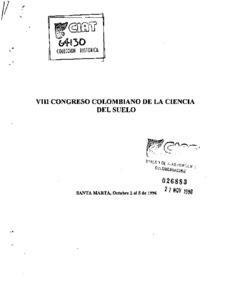Características estructurales de los suelos de los Llanos Orientales de Colombia sometidos a varios sistemas de manejo
Soil productivity and sustainability depends on the building and/or conservation of an adequate and dynamic equilibrium between physical, chemical and biological properties and processes in the volume of soil explored by roots, so that there is no constraints in the availability of water and nutrients to plants. Soil structure is one of the soil properties that is more vulnerable to the intensity of use in tropical soils. Aggregate size distribution, aggregate stability and pore size distribution are some of the attributes that are usually used to describe structural changes and can act as indicators of structural sustainability. This paper presents and discusses the behaviour of these attributes under different soil management treatments (native savanna, Brachiaria alone; Brachiaria + legume and monocrop) in the Colombian Eastern plains soil classified as Typic haplustox kaolinitic isohyperthermic. These results showed highly statistical significant differences between treatments in the parameters studied and allow to conclude that aggregate size distribution and stability could be indicators of susceptibility to degradation.

